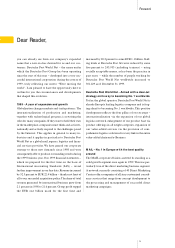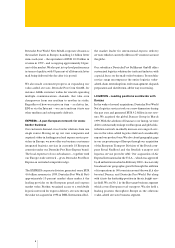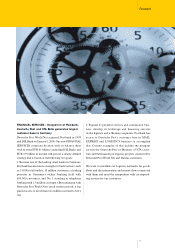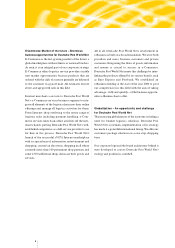DHL 1999 Annual Report Download - page 17
Download and view the complete annual report
Please find page 17 of the 1999 DHL annual report below. You can navigate through the pages in the report by either clicking on the pages listed below, or by using the keyword search tool below to find specific information within the annual report.
At the same time,the increasing integration of physical
flows with information and financial flows is leading to
the emergence of new service packages which go by the
name of supply chain management (SCM) services.
Reliable logistics, distribution and financial services
providers are an indispensable prerequisite for success-
ful outsourcing and SCM projects. This situation offers
companies which are able to offer the entire range of
services from a single source – in other words, one-
stop-shopping – a unique opportunity.
The e-Commerce revolution
The Internet and the many other new means offered by
information technology are dramatically changing the
rules governing the global economy. They are creating
worldwide transparency,opening up new ways of access-
ing new markets and giving rise to entirely new business
models.
This has a fundamental impact on the transport, logis-
tics and service sectors and on payment systems. In
particular, the electronic handling and execution of
business transactions – known as “e-Business” – will
require new kinds of services.This development is being
shaped by a number of global trends:
• Manufacturers are stepping up their direct sales activi-
ties. This in turn is leading to the elimination of
various commercial levels in favor of end-customer
commissioning.
• Item flows – in both the business-to-business (B2B)
and the business-to-consumer (B2C) areas – are
increasingly segregated. Customer demands for
greater speed and reliability are also growing.
• New intermediaries (distributors/dealers) are estab-
lishing themselves in the electronic net with a value
added that they generate primarily by improving infor-
mation and financial flows.
• The growing globalization of business relations is gen-
erating ever-larger international transport volumes and
fueling a need for integrated global solutions – in other
words,for global transparency in offerings and prices.
This scenario offers logistics providers an enormous
opportunity to play an active and decisive role in
expanding and shaping these developments. Many
companies need help in organizing, coordinating and,
most of all,executing their business transactions.Logis-
tics services providers are qualified partners for meet-
ing these needs.
The so-called “pure plays” of e-Business – companies
that devote themselves exclusively to marketing and sel-
ling products and services in the Internet – are particu-
larly dependent on partners who can manage the entire
physical and financial side of their business activities
for them.
2.2 Specific market opportunities
We expect our markets for mail, express, logistics and
financial services to continue growing in future years.
16
e-Commerce growth B2B
e-Commerce growth B2C
U.S.A.
W. Europe
Germany
U.S. $ bn
800
700
600
500
400
300
200
100
98 99* 00* 01* 02*
98 99* 00* 01* 02*
Grow th
rates
110 %
162 %
162 %
U.S.A.
W. Europe
Germany
U.S. $ bn
80
70
60
50
40
30
20
10
Grow th
rates
76 %
127 %
125 %
Source: Forrester, IDC * estimated
























